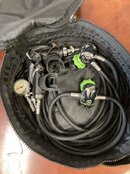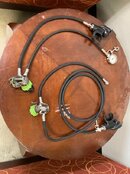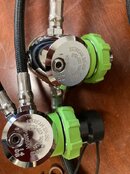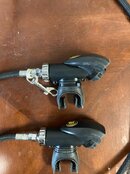Having a servo does not imply harder breathing.
As with all things scuba, it comes down to tuning. An Xstream tuned to 1.1" at an IP of 109-123 is sweet. It's the onset of the breath that is slightly more "square wave" than with a lever design. A lever valve goes from "barely cracked" to full flow based on how hard you suck, with at some point Venturi kicking in and maintaining flow at less effort until you exhale and shut the valve off.
In contrast, a servo design is like a trigger. The transition from servo valve opening to main valve opening is very short, and having a high IP makes the sensation almost uncomfortable, simply because the Poseidon outflow is so large. It works, but you don't need that much gas.
The other problem is vocabulary. The Poseidon service manual says "cracking effort". But it's not! It's
dynamic inhalation resistance. It's supposed to be 1.1" during a
very light inhalation. If you tune it so the servo doesn't crack until 1.1", main valve opening won't be until 1.4"+.
Make sure your tech tunes it so the effort is 1.1" during a tiny breath, and not when the servo cracks open.
A great resource in the service manual is the field tuning technique described on page 40 of the manual. A simple dip into a water basin can measure your cracking effort just as precisely as with the magnehelic! But again, the problem is vocabulary. What the manual calls "sizzling" is not the tiny champagne bubbles of servo opening, but the slight flow as the main valve begins to open. It requires practice to develop a technique of slowly immersing the second stage (purge button down and vertical) until the main valve starts to open. When that starts to happen, you need to quickly pull back 1/4"-3/8", before water is sprayed everywhere. When you find that stable light flow depth, the distance from there to the center of the purge button is your dynamic inhalation effort in inches WC. For optimal light tuning, that stable flow depth should be at the top of the lower necklace loop. Easy, peasy, albeit requiring a little practice. And if you need to retune the reg? A 1.5mm hex key to loosen the hex stop and a surgical forceps will rotate the valve tube closer to, or farther away from the diaphragm, to lower or raise breathing effort, respectively.
Don't use your finger tip to depress the purge button. Use the flat of your finger - it's a trigger. You don't get more flow from pushing harder, and if you jam your fingertip into the button, you can tilt the servo past its 35° limit and bend the shaft. That's unrepairable and requires a new $65 part. They tried to engineer that out with a very stiff purge button, but that just means a SEAL will jam harder. It's a real issue for the Navy because it requires a change of habit, and that comes slowly.
SOAK your second stages overnight in the sink after a dive trip. It's hard to get the salt out of the crevices with just a flush. Salt crystals accumulating in the tiny servo valve may cause it to stay open. If you are adept, and have a scuba tank, with regs
unpressurized, consider pressing the purge button for a ONLY a half second with the diaphragm end of the seconds hanging vertically in the sink, with the purge button end just below the water's surface. Don't submerge the entire second stage. This will allow a
tiny bit of fresh water to flow
around the servo valve. Let it hang vertical on a towel bar for 20 min, then pressurize the reg set and
barely push the purge button until you can hear gas escaping from the servo, but before the main valve opens. Let it hiss a bit to dry out the servo and you're done!
Unfortunately, that's too complicated to put in the service manual, because if you flood the whole top end, the valve will not function and will freeflow until the reg is disassembled and the main valve is dried. That's because the valve shuts off from gas passing through a calibrated tiny hole into the servo compartment. If you plug that hole with water, the main valve won't close.
It's an extraordinarily elegant and yet simple mechanism, but some Swedish overengineering has created a few pitfalls for those unfamiliar with the valve.
credit goes to my friend
@Fibonacci 's superb drawings.







